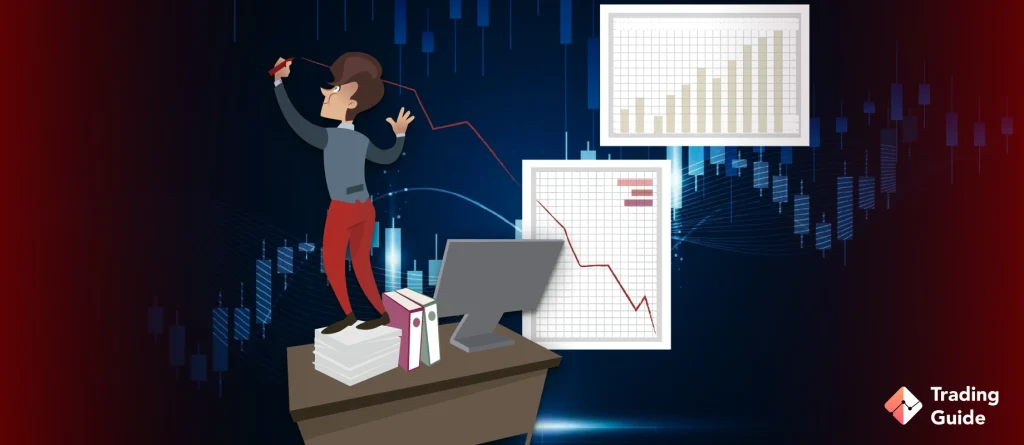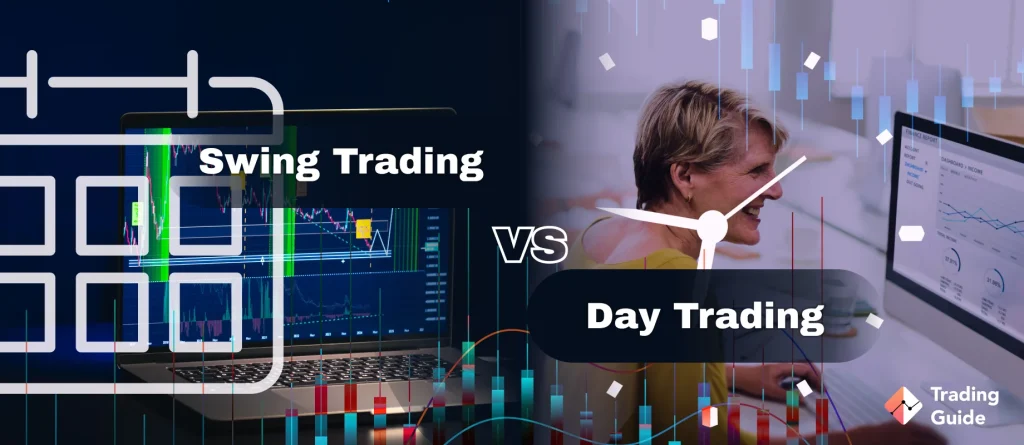Have you ever wondered what swing trading means? That’s great – because we have all the answers that you’re looking for.
On the following page, we will walk you through the concept of swing trading as well as offer a selection of useful tips that you can use to optimize your trading efforts.
Swing trading, when used correctly, is a highly efficient trading strategy. Although to get the full benefit of the strategy, you first need to study it and learn the ins and outs of trading. Therefore, we strongly advise you to read our swing trading guide before you venture out and start trading on your own.
The Basics: What is Swing Trading

Swing trading is a popular short-term trading strategy that makes use of short to mid-level trading windows, unlike day trading that makes use of short to very short trading windows.
This means that a swing trader typically opens and closes positions within a few days to a couple of weeks – sometimes even months. By doing this, traders can make use of traditional market movements that can be analyzed and predicted accurately using different methods.
Swing trading originated from the stock market and is still a popular way to trade stocks around the world. However, the same concept can be applied to any market, financial instrument, and asset.
For example, a lot of people swing trading commodity spots, cryptocurrencies, and bonds. With that said, swing trading is not always optimal for CFD trading and forex trading. Since most online brokers apply overnight fees to positions that are opened outside of regular trading hours, you will be charged more to swing trade on these markets.
There are some people that swing trade CFDs and currencies and you could as well. Just remember to include all the additional fees when planning a trade.
You should also be aware that swing trading poses some risk that other trading concepts do not. We go through these said risks in a section further down on this page.
The Benefits of Swing Trading

There are many different benefits to swing trading. For example, compared to day trading, swing trading doesn’t require as much time spent analyzing and actively trading. Instead, you can spend a couple of days analyzing the market, finding the right opportunity, open a few positions, and then only checking in on your trades every now and then.
A day trader, on the other hand, will have to continuously analyze markets looking for opportunities to open and close new positions throughout the day.
Another benefit is that it is rather easy to apply reliable risk management techniques and tools to your swing trading efforts. As a serious swing trader, you should assess the risk/reward for each trade and place suitable stop-losses to protect yourself from unnecessary losses.
Also, since you will keep your positions open for longer periods of time, the market movements will be greater than for a day trader. Therefore, you will not have the same need to use leverage and margin on your positions, thus, limiting the risk further.
At the same time, the use of leverage and margin can be a huge benefit that allows you to multiply your profits. For instance, if you want to open a position worth £10,000, you can put in £5,000 of your own funds and £5,000 in leverage.
However, the main benefit of swing trading is that you traders can use rather simple analytic methods.
In fact, one can swing trade profitably and only rely on technical analysis for all the analytic work and planning. In other words, there is no need to apply fundamental analysis to the stocks you trade.
Naturally, you still need access to sophisticated charting tools and a reliable broker to perform at your best.
Risks with Swing Trading

As mentioned earlier, swing trading poses certain specific risks that other forms of trading do not.
The first risk that comes to mind when talking about swing trading for beginners is overnight and weekend risk. When keeping a position open aftermarket hours you run the risk of getting stuck in massive market reversals when the exchange opens again.
As you probably already know, stocks and other instruments are known to experience the greatest market movements in connection with the market opening.
When focusing on mid-length trading windows, you miss out on all the potentially profitable short market movements that day traders make use of.
There is also a bigger risk that swing traders end up “panic selling” their instruments too early due to quick market movements. In turn, this results in lost profits and even substantial financial losses.
Swing Trading vs. Day Trading

We’ve already touched on this subject but we know there are a lot of you wondering about the difference between swing trading and day trading. And the answer is quite simple.
Swing trading and day trading share a lot of similarities and compared to long-term investments, they are very similar.
What sets day trading and swing trading apart is the length of each trade, which, in turn, affects the way you analyze assets and plan your strategies.
When day trading, your goal is to benefit from many small market movements throughout the day. A position can be kept open for as short as a couple of minutes or even less than a minute. This makes day trading perfect for volatile market conditions.
Swing trading, on the other hand, focuses on longer market movements and each position can be kept open for several weeks on end.
In many ways, these differences make swing trading easier than day trading. It’s especially easy to accurately predict market conditions.
However, that does not mean that swing trading is easy or safe. All forms of trading are associated with risk and swing trading is no exception. Therefore, you need to apply caution and ensure that you have the knowledge, funds, and tools needed to trade efficiently.
We provide all the guides you need to maximize your efforts. The core of this site is also unbiased broker reviews aimed to help you choose the best broker for swing trading based on your specific needs and requirements.
Swing Trading Strategies That Actually Work
Before taking a closer look at some of the proven swing trading strategies that you can use, we have to explain another thing that is unique to swing trading.
Using stocks as an example, most long-term investors would tell you that you should never buy a stock unless you can expect 20% to 25% profits during the said time frame. When swing trading, due to the shorter time factor, you can’t expect the same profits. Instead, you should aim to open positions that could pocket you 5% to 10% profits over a period of, let’s say, 10 days.
At first, this can seem like a disadvantage, but don’t forget that 10% profit during 10 day periods, quickly adds up to a significant amount.
Below, you can read more about three popular, trusted, and tested swing trading strategies aimed at beginners. For more advanced trading strategies, please refer to our corresponding guides.
There is an unwritten rule in stock trading that assets that have gained for a longer period of time, will continue to gain. Similarly, a stock that has been decreasing in value for a longer period of time, will likely continue to do so.
Obviously, this is not always the case and sooner or later all instruments switch from being bull to bear and vice versa.
Based on this rather vague concept, you can apply a basic swing trading strategy only based on market trends.
This is also a basic swing trading strategy that even beginners can make use of with satisfying results.
The concept revolves around the idea that you only want to trade stocks (and other instruments) that are trending upwards. And the best way to locate those instruments is to first locate the market sector that is outperforming all other sectors.
Then you have to locate the instruments within that sector that is driving the most of the upward trend.
Since swing trading is a short-term trading strategy, there is little risk that a market trending sector will turn before you manage to close your positions “in the green”.
It might sound boring but we’re completely serious when we say that risk management is the best swing trading strategy, especially for beginners.
The idea of any trading strategy is to maximize profits and make trading easier. And as you probably guessed, it’s impossible to make a profit when losing money. Also, if you implement good risk-management solutions, you can focus more of your time on the actual on-hand trading strategies.
Therefore, more so than being a great swing trading strategy for beginners, risk management should be a part of every trading strategy, regardless of your experience, budget or trading plan.
Read about the best trading computers in our other guide.
FAQs
Swing trading is a short-term trading strategy where a trader aims to profit from short to mid-level trading times. The average swing trading position is kept open for between 5 to 10 days, but they can be closed sooner or later than that.
Unlike day trading where you open and close several positions a day, swing trading allows you to open a position today and then not worry about it too much for a week or two.
Compared to long-term investments, short term positions are much shorter. For example, a stock investor could buy a stock today with the intention to sell it with profit 2 years from now.
As a beginner, if you’re interested in learning how to swing trade, please refer to the guide on this page. In addition to offering basic information about swing trading, we’ve also shared three basic strategies as well as countless pointers to get you started.
Forex swing trading is exactly what it sounds like: swing trading forex (currency pairs). In other words, it involves you opening a forex position today with the intention to close it and pocket the profit in a few days or weeks from now.
Please note that forex swing trading is not always optimal due to the overnight fees and potential overnight risks that the forex market is characterized by.
Swing trading stocks is rather easy. Stocks also happen to be the most common instrument to trade using this strategy. Similar to all swing trading, your goal is to buy and sell stocks within short to mid-level time frames.
To start swing trading stocks, you first have to learn how to analyze the market in search of opportunities. This is easier said than done, and we recommend that you check out our stock trading guides for more information.





You would not have time to sit and watch the markets every minute, every day. You can better manage your risk and protect potential profits through stop and limit orders, getting you out of the market at the price you set. Trailing stops are especially helpful as they trail your position at a specific distance as the market moves, helping you to protect profits, should the market reverse.